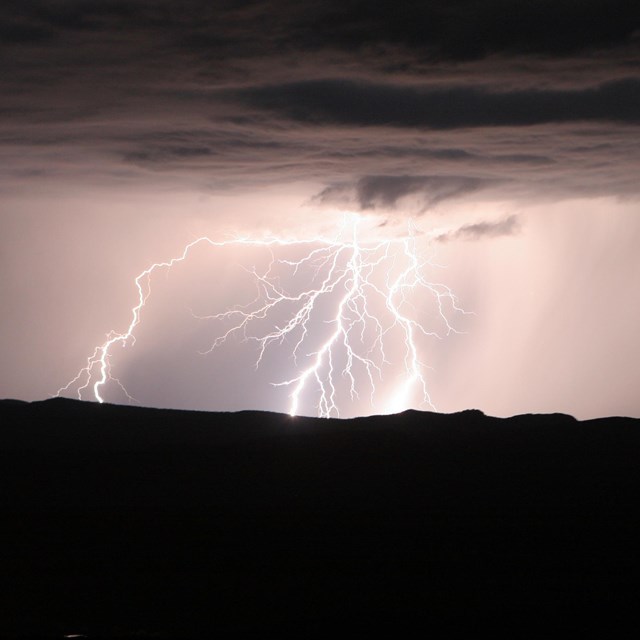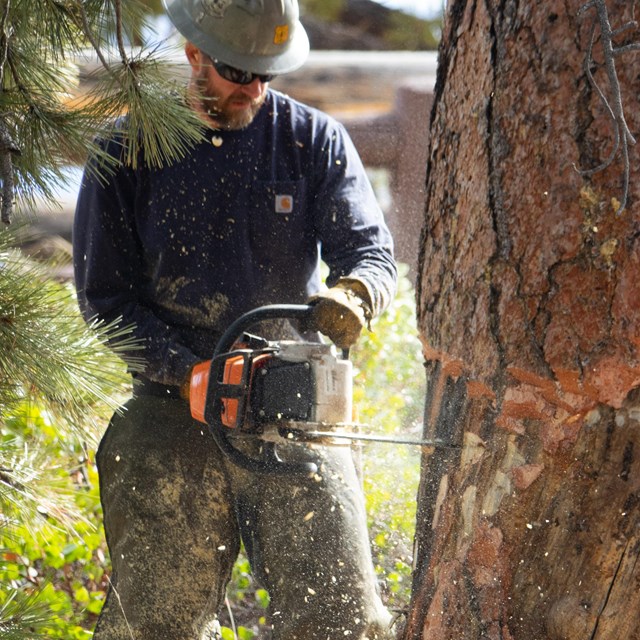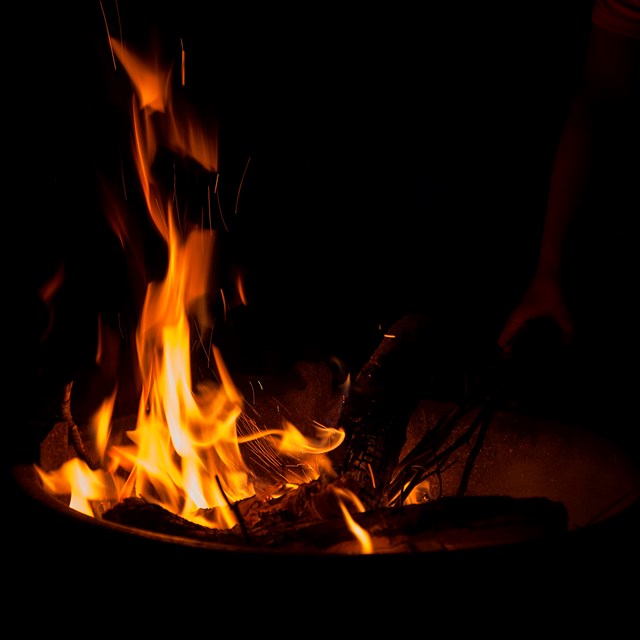
NPS Photo 
Forest SuccessionA fire sweeps through a forest, leaving behind blackened trees, burnt grasses, charred shrubs, and scattered ash. Though the aftermath may sound desolate, a fire like this creates opportunities for new life. Given time, grasses will start to grow back as their seeds are brought on the wind. Shrubs will regrow from their roots, encouraged by the new nutrients and warmth from the black ash in the sun. Without shade and competition, new trees will sprout up from the ground. Birds and bats will use the remains of burned trees for shelter until the new trees grow tall enough. Other wildlife will also return with the young plants. It may take time, but a forest can recover from a fire in this way, through a process called “succession”. “Stand-replacing fires” completely reset a forest ecosystem, allowing the succession process to start over from scratch. Historically, these kinds of fires are not common in western forests. At Bryce Canyon, it would be much more common for lightning to start a fire about once every 7-8 years. There was not enough time between these fires for fuel to build up in the same way as it has today, so each individual fire would be less destructive. Rather than burning everything, these fires might only destroy the grasses and shrubs on the forest floor. The older trees might be singed, but many of them are capable of surviving these kinds of fire. Even so, why would plants or animals choose to live in places that would be dangerous for them? Why are Today's Fires Often so Destructive? Many western forests are in a late stage of succession, almost untouched by fires since the 1900s. These forests are heavily shaded by tall, old trees. The gaps between the trees have been filled in with a dense tangle of shrubs and fallen branches. Without the threat of fire, other kinds of dangers have taken its place. Disease and harmful pests like mistletoe and bark beetles have become more abundant as the forests have grown thicker. They weaken these trees from the inside, sometimes causing a premature death. Mistletoe can also cause unusual growth patterns of densely packed branches, called “witches’ brooms”, in some kinds of trees. Between the extra branches and the dead and dying trees, late succession forests are filled with fire fuel. One well-placed lightning strike could be enough to destroy the entire stand of trees.

NPS Photo Adaptations to FireGrassesAs the smoke clears from a fire, the forest floor is black and barren, covered in ash. Later in the summer, the same breeze that scatters the ashes will carry something else, too: seeds. Many grasses have seeds that travel on the wind. If the conditions are right, those seeds will take root and sprout new grass. The blackened forest floor, with its extra nutrients and heat from the sun, is a perfect home. After a fire, grasses like Indian rice grass are some of the first plants to start growing again. Though grasses themselves are flammable, they help to encourage the cycle of fire, creating a good habitat that they can quickly repopulate. ShrubsAmidst the grass, clumps of green leaves emerge from the charred remains of a small bush. Although this bush may have looked dead after the fire, its underground roots were still very much alive. Many shrubs at Bryce Canyon; including greenleaf manzanita, mountain snowberry, and Utah serviceberry; can be “top-killed” by fire. While the fire might destroy the part of the plant above the ground, the roots underneath are protected from the heat. When they are ready, they will send up new shoots from the old roots. This can take some time, and usually happens after the grasses have already come back. 
NPS diagram 
TreesAround the same time as the shrubs, tiny sapling trees sprout from the ground, leaves trembling in the slightest wind. These are quaking aspen, which will eventually grow into a tall tree with paper-white bark. Just like the shrubs, aspen roots will usually survive a fire even if the tree itself doesn’t. Unlike the shrubs, aspens can have interconnected root systems extending for miles! Quaking aspens are often the first kind of tree to come back after a fire, sometimes even if there weren’t any aspen in the area before the fire. During the fall, it can be easy to tell where a recent fire occurred by the reds and oranges of the aspen leaves covering a slope. Look for them on a hillside along the scenic drive near Rainbow Point, where they are returning after the prescribed Puma Fire in 2008.Eventually, small trees with needles will start to make their way back into a burned area. Some trees, however, might not have been affected by the fire in the first place. Even after a fire, ponderosa pine trees are often left standing. Tall and sturdy, with reddish-orange bark, the ponderosa pine is one of the most common trees in Bryce Canyon – and for good reason! They are also the most fire-resistant. How do Ponderosa Pines Defend Themselves Against Fire? The ponderosa pine's thick flaky outer bark keeps the sensitive inner wood from getting too hot. As the flakes catch fire, they fall off the tree, making it difficult for the tree to continue to burn. Fewer low branches also prevent fire from climbing the tree to living needles higher up. Deep taproots reach underground, collecting nutrients and water from unburned soil. When fire sweeps through a ponderosa pine forest, it kills sapling trees that could grow up to create a crowded forest. Since ponderosa pines prefer lots of sunlight and plenty of personal space, frequent ground fires help to maintain their ideal habitat.
Learn more about how the ponderosa pine is adapted to living in an environment shaped by fire in the 6 minute Living With Fire video. 
WildlifeThroughout the process of succession, animals continue to thrive off of the resources that are available. In the case of a fire, most animals are able to move out of the area before the fire becomes dangerous. Once the flames are gone, they will begin to move back into the burned area. Birds and bats will often make new homes in the snags, or standing dead trees, created from the fire, finding shelter in the spaces between the burned bark. Herbivores and pollinators will find tasty treats in the new plants and flowers that sprout from the ashes. As the forest regrows, wildlife will continue to return. How Fast Does Succession Happen? Depends on the fire! One way we can document succession is through photographing an area over time. You can help us document succession after the Bridge Fire by taking a picture of the landscape at the Whiteman Bench Picnic Area along the Southern Scenic Drive (mile 9.5) and posting it on social media using the #BridgeFireSuccession hashtag.
Fire impacts different ecosystems in different ways. Learn more about wildland fire in ponderosa pine forests, or explore fire ecology stories from around the National Park Service!
Visit our keyboard shortcuts docs for details
Explore how the ponderosa pine is adapted to living in an environment shaped by fire.
|
Last updated: July 3, 2023



